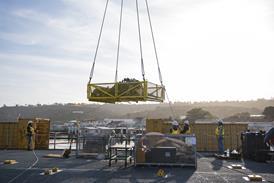Julian Moxon/PARIS

Flight testing of the Rafale's front sector optronics (FSO) system began in April, aboard the Dassault Mystere 20 "avion banc d'essai" testbed aircraft. It will be the first fully integrated optronic surveillance and tracking system installed on a European fighter aircraft. It is in some ways more advanced than equivalent systems in the USA, says programme manager Thomson Optronique.
Development has been held back because of the overall delays in the Rafale programme, but also because of the immense task of ensuring the system is fully integrated with the radar and electronic countermeasures to provide the multirole capability which is key to the Rafale.
The "eyes" of the FSO comprise the infrared system (on the right hand side) and TV/laser on the left, mounted on top of the nose, in front of the pilot. Thomson Optronique is responsible for overall integration and for the TV and laser ranging elements of the FSO, Sagem the infrared component. The signals from both devices are fed to a dedicated computer mounted directly below the scanners, between the radar and its processor.
The FSO provides air-to-air and air-to-surface surveillance. The air-to-air component and the air-to-surface is still under development. "The first flights we have made have given us good confidence in the system," says Thomson Optronique.

The FSO is slaved to the aircraft sensor system and can work either as a standalone sensor or in conjunction with any other sensor such as the radar, Spectra self-defence system, or missile seeker. It scans at the same angular speed and looks at the same area of sky or ground, according to the search/track mode set by the pilot. Interception, for example, requires a wide sweep, to look for targets, while combat sweeps involve smaller angles (the figures are classified).
The infrared scanner works in the 3-5mn and 8-12mn bands, providing a 3-5mn capability for the first time in the west, says Thomson Optronique commercial director Jean-Claude Vergnères. This wavelength provides "considerably better detection capability in humid conditions", he adds.
The TV provides tracking, identification and three-dimensional acquisition for weapons lock-on (using the laser ranging function). It has a narrow field-of-view of less than 1¼, for precision and high resolution (and therefore target identification) at long range.
Coupling of the FSO to the radar is set for 2001/2. The aim is to have the system up and running for installation in the F2 version of the Rafale by 2003, which will have air-to-air and air-to-ground capability. Full Rafale multirole capability comes with the F3 version, due to become available in 2006.
Thomson Optronique declines to give exact performance details of the FSO, but it is understood that at 20,000ft, for example, in air-to-air mode, the system will have an infrared detection capability of around 130knm, while laser ranging is possible out to about 33km, and the TV is capable of looking out to 45km.
FSO images can be viewed on the mid-level display or either of the main cockpit displays. Radar and TV images cannot be mixed, although work is known to be under way on ways of fusing the two images. At present, however, only discrete images of either the radar, TV or infrared can be viewed. Selection of which screen provides the imagery is through the pilot's stick-mounted Hotas control.

Rafales will also be equipped with the Damocles infrared air-to-ground targeting and "pseudo-recognition" pod developed originally for the Mirage 2000-9 sold to the United Arab Emirates (in which application it is called the Shehab). The pod brings full air-to-ground capability for day/night targeting, the "pseudo-recognition" capability providing limited intelligence on the nature of the target. It is compatible with existing and all currently planned future weapons, including long-range laser and TV guided and inertial navigation/global positioning system-guided weapons and missile imagery seekers. For imagery weapons, due to the "very high image quality", the pod will provide the reference image for the seekers. It can either work autonomously or with a laser spot tracker. In self-designation mode the Damocles has a range of 30km at 20,000ft with a temperature differential of 2k. For INS/GPS it provides real-time identification of moving or fixed targets with three-dimensional localisation, with a claimed range of 40km at 25,000ft. The infrared camera works in the 3-5mn range, while the 300mJ laser provides illumination and range-finding.
Source: Flight International























